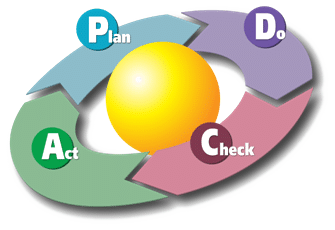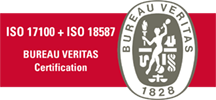A Systematic Approach to Translation Excellence
At M21Global, continuous improvement is not just a practice, but a culture rooted in all our processes. Every piece of feedback and result obtained is meticulously analysed, communicated to our team and recorded in our databases. This systematic practice allows us to continuously improve and refine our services.
Our commitment to continuous improvement, combined with the relentless pursuit of excellence, is a reflection of our dedication to total customer satisfaction. This commitment is further reinforced by our adherence to ISO 17100 certified quality standards.
We adopt the PDCA cycle, a classic and proven approach to continuous improvement.
PDCA Cycle at M21Global: A Systematic Approach to Translation Excellence
Customer Objective: Before starting the project, we seek to deeply understand the customer’s objectives. This may involve understanding the translation’s target audience, the desired tone, cultural specificities and other relevant details.
Analysis of Needs: We evaluate the texts to be translated, identifying specific terminologies, linguistic nuances and other potential challenges.
Action plan: Based on our analysis, we draw up a detailed action plan, which includes selecting the appropriate glossary, allocating specialised translators and proofreaders and setting deadlines.
Defined Methodologies: We implement the best translation practices, ensuring that every word is translated accurately and in context. The technological tools developed in-house at M21Global are used to ensure consistency and efficiency.
Collaboration: We promote collaboration between translators, proofreaders and other team members to ensure that the project is executed in a cohesive manner.
Internal Monitoring: We continuously monitor the progress and quality of the translation using our technological solutions, and identify areas that may need additional attention.
Customer Feedback: We value feedback from our customers and therefore encourage collaborative review. This step allows us to ensure that the translation is aligned with the customer’s expectations and needs.
Comparison of Objectives: We evaluate the final result in relation to the objectives initially set, ensuring that all goals have been achieved.
Implementation of Improvements: Any deviation identified in the evaluation phase is promptly corrected. In addition, we use this learning to improve our internal processes.
Commitment to Excellence: Commitment to Excellence: At M21Global, continuous improvement is not just a goal, but a daily practice. We are constantly looking for ways to raise the standard of our services, reinforcing our commitment to total customer satisfaction and ISO 17100 certified quality.

The 3 Phases of Quality Control in Our Translation Services
At M21Global, quality is not just a goal, but a promise we make to our customers. Each translation we carry out goes through a rigorous quality control process, ensuring that each word translated follows the highest quality standards, and complies with ISO 17100 quality certification.
Before starting any project, we carefully prepare the glossary to be used, adapting it to the specifics of the text to be translated. This glossary is sent to the client for revision, thus ensuring the terminological consistency of the translation.
During translation, we use technological tools developed in-house to continuously monitor the quality of the translation, identifying and correcting any deviations from established standards. This is the first phase of Quality Control.
After completing your translation, the translator reviews their own work, refining any areas that could be improved.
The translator’s work is analysed again after the translation is finished, before moving on to proofreading. Any inconsistency is promptly communicated to the translator, so that they can correct their work in a timely manner, and ensuring that the translation delivered complies with our quality criteria. This is the second phase of Quality Control.
Next, a specialised proofreader reviews the translation, comparing the original text with the translation and correcting any inaccuracies that may still remain in the text.
Finally, the project manager checks the completed work, the translation’s compliance with the Glossary, as well as formatting and other essential details. This is the third and final phase of our Quality Control process.
Request a Translation Quote Now
Why wait? Ask for a quote and discover what we can offer you!

